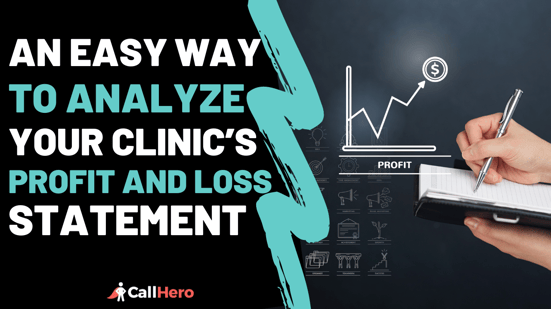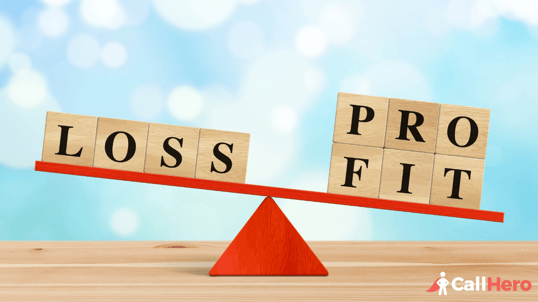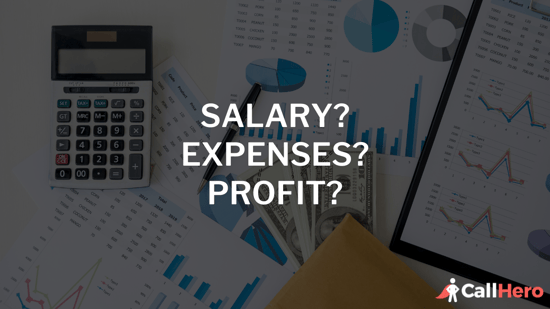
The Easy Way To Analyze Your Clinic’s Profit and Loss Statement To Put More Money In Your Pocket
One of the hardest things clinic owner Kathy had to face was looking at her P&L (profit and loss statement) and dealing with it. She would get this dreaded anxious feeling whenever she looked at it.
But it's so important to look at it regularly. It's important to know how to analyze it and ask the right questions. When Kathy learned this she discovered that she was missing $45,000 because of booking errors.
If she didn't know how to analyze a P&L statement properly she wouldn't have found this very costly error. Now you don't have to understand all of it in order to boost your profits.
The most important thing is knowing what to look at, asking the right questions, and knowing what the ratios and risks are.`
When you know how to look at your P&L statement it will put more money in your pocket.
And that’s what we’ll talk about now…
You see your weekly scoreboard and P&L statement are cousins because the weekly scoreboard tells you operationally what you need to focus on this week. With the P&L, you need to ask “why is this like that?” You need to go investigate it or ask someone.
Also, you want to look at the ratios and risks of keeping it in-house or outsourcing it.
If you keep it in-house you want to have a person with an accounting background. We made the mistake of trying to teach our office manager to do it which was a BIG mistake.
Because when you have bigger numbers you'll have bigger problems.
Risk of keeping it in-house:
If that person leaves or goes on vacation does this stop? If you go in this direction you need a backup plan in place. You need to have a company on speed dial to take over immediately if they leave. You don't have to have one right now just someone on speed dial.
Benefits and Risks of outsourcing it:
When you hire a company to do it for you. If someone leaves they just bring in someone else. Also, it may be cheaper than in-house. However, the risk is they don’t know your business or you as well. Whereas having someone in house they know you and your business well. And might be able to spot flaws in your P&L better.
Next, let’s talk about the importance of ratios on your profit and loss statement.

We were looking at someone's P&L on a recent community call and one thing that jumped out is they didn't have any ratios. Like what percentage of gross profits was his inventory sales? What percent of gross sales is his admin salary? You can add this easily in google sheets or excel.
You want to keep your expenses as stable as possible while your revenue grows. And ratios help with that.
Now, these percents do not have to be exact, could be a range. The reason ratios are so important is it’s your guide for letting you know when you need to pull the lever to stay in that range. When you ask the question why is this happening? The ratios let you know where to focus your eyes.
For example, if you're at 0-1% for inventory sales to gross profits. There is a big opportunity here. You can ask what are we doing now that we should be doing that we are not? We can make this a quarterly goal to improve these numbers.
What other thing can you provide to the client that increases their customer service? But it needs to be part of the patient experience, not your clinician having to sell it. These questions can help come up with ways to get more product sales.
Next, you want to look at…
What is the range of admin salary and wage expenses to your profits?
It should be less than 15% is where you want to be sitting. But some clinics are different. it's not black and white.
For example, one clinic owner on the call is ok with going a little over that percent because she understands the risk. She is okay with spending a little more to get more. Because it frees her up to do growth things. So she is willing to take the increased financial risk to do other things to grow the business. It's an investment to her.
You can also mitigate your risk if you don't want to hire someone. You could get a company to answer your phones instead of in-house if your answer rate is low.
You can get creative with risk to reduce it.
It's great to have a bookkeeper that will spot these flaws and tell you instead of you doing it each time. Someone who knows your business. Why is your hr ratio for RMT 120%? Did you change something vs you saying this doesn't make any sense? Also, some owners will try to justify it so it’s good having someone else point these flaws out.
Next we looked at…
Train Your Receptionist To Convert More CallsAchieve 95% answer rates and 80% booking rates with CallHero’s training and AI software
|
What percentage ratio should your marketing be in your clinic?
At least 6-7%
For example, for a marketing coordinator do you outsource it or keep it in house. What's the risk? One way to look at it is are they getting you for every $1 spent on marketing $3 or more back? You want to track this ratio.
When going through your P&L statement what are the biggest things that really move the needle? Just focus on those first. Those make the biggest impact on your profits.
Check out this video to learn the 5 proven ways to help increase your Clinics Profits.
Like one way to cut expenses and boost profits… is by hiring a virtual front desk.
Because of inflation and Covid, most people don’t want these low-paying receptionist jobs anymore. So it’s hard to find qualified people without breaking the bank.
That’s where Callhero’s Virtual Receptionist can help.
You'll Get A Virtual Receptionist Fully Managed & Trained For Taking Calls and Converting Callers Into Appointments… For A Fraction Of The Cost Of A Full-Time One.
Best of all you don’t have to train them, manage them, worry about them leaving, or going on vacation.
Our Virtual receptionist service never takes a break or time off. And they’re trained by the best of the best at converting callers into scheduled appointments. So Callhero’s Virtual Receptionist not only cuts your costs but helps boost your profits even more by converting even more callers into scheduled appointments.
FAQ
1. Should I outsource my bookkeeper?
It depends on your situation. For example, some clinic owners like to keep it in house which helps spot errors better for them.. Because they know them and the business much better than an outside company. Others prefer to outsource it so they don’t have to worry about them leaving.
2.How do you read Profit & Loss reports?
To read a P&L report, start by reviewing the total revenue and then subtracting the total expenses. This will give you the net profit or loss for the period. Then, examine each line item in the revenue and expense sections to get a better understanding of where the money is coming from and going. P&L reports can be complex, but with careful analysis they can provide valuable insights into a clinic's financial performance.
3. What is margin in Profit & Loss statements?
Margin is the difference between revenue and expenses. It shows how much profit a company makes after subtracting all its costs. Margin is typically expressed as a percentage of revenue. For example, if a clinic has a margin of 10%, that means it makes 10 cents in profit for every dollar of revenue.
Who is Rick Lau and CallHero?

Rick has built three 10 million dollar healthcare businesses over the past 15 years including a network of 127 clinics with over 1400 employees. He is one of the most sought-after mentors for clinic owners in Canada and USA where he helps owners double, triple, and even quadruple their profits by optimizing their clinic operations using his proven systems and leadership strategies. Plus, he has spent over millions in google and facebook ads during his career.
You can follow him on Instagram





